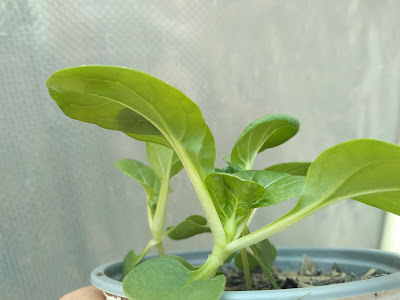Bok choy (Brassica rapa) is known for being a fast growing and nutritious vegetable. Most bok choy varieties are relatively small and good for balcony farming. This year I am growing a tiny extra dwarf bok choy variety called 'Hedou'.
From all accounts, bok choy is a highly nutritious vegetable, very fast growing, and being extra compact in size makes Hedou bok choy super cutie. All of this makes Hedou Bok Choi perfect for urban farmers and gardeners with limited space. Being so cute and fast to grow also make it easy to get kids involved in gardening.
 |
| Hedou Bok Choy |
 |
| I grew some Bok Choy in pots for seed saving |
The Hedou variety of micro Bok Choy seems to have some internet hype, yet very little actual information can be found anywhere on the internet. There are a few pictures here and there, and a few places selling seed, but that is about all.
I grew some of these in the veggie garden between other vegetables where they took up next to no space. Brassicas tend to cross pollinate like mad, so I grew some in small pots in my greenhouse for saving seed.
As there is so little information around I decided it would be good if I recorded my progress to give an idea of what to expect when growing Hedou tiny bok choy. The first time I soaked seed overnight, the second planting I didn't, I have recorded both below.
Being in Australia, dates are written Day/Month/Year.
 |
| Hedou Dwarf Bok Choy |
 |
| Hedou Bok Choy gets some petiole/stem colour with high light |
Days to maturity Hedou Bok Choy (Brassica rapa)
Seeds soaked 18/11/2022 Day -1
Seeds planted 19/11/2022 Day 0
Germinating 22/11/2022 Day 3
Heads forming 10/12/2022 Day 21
Flowering 24/12/2022 Day 34
Seeds ripe 25/01/2023 Day 67
I also planted some Hedou Bok Choy without soaking them first:
Seeds planted 17/12/2022 Day 0
Germinated 20/12/2022 Day 3
Harvest from 13/01/2023 Day 27 (Note: most bolted to flower)
Flowering 16/01/2023 Day 30
On the face of it, three or four weeks seems like an absurdly short amount of time from planting the seed to harvest, especially when you consider that many other vegetables take 10 or so days to simply germinate. When I look at how small these plants are, and how quickly they germinated, it makes sense.
To be clear, they won't always take three weeks, they may take four or five under harsher conditions, but this is still very fast.
If conditions are bad (too hot, inconsistent watering, too cold etc) they may bolt to seed early. The heat hit so my second lot bolted to flower. If this happens you can harvest and eat them before they send up a flower stalk. They still taste the same. If you let the flower stalk get too tall they get a bit tough and stringy. Once they have reached this point you can just allow them to flower and set seed. Hedou is a stable heirloom variety that will breed true to type. If your neighbour has any form of Brassica rapa flowering they will probably cross, any F1 seedlings will still be edible.
Hedou Bok Choy grow fast, and are small at full size. Most people eat several of these in a meal, meaning you harvest what you eat and you eat what you harvest - there is never any waste, and never anything to store. You can also grow an awful lot of plants in a tiny space, so their small size can be an advantage.
 |
| Hedou Bok Choy Flowering |
Hedou Bok Choy happily grows in a small pot of soil meaning it can be easily grown with no land and easily tended by children or the elderly. This would be a great vegetable to grow in a school kitchen garden as the time from seed to harvest is so short.
I think succession planting is key, each time you harvest some you plant some more seeds, and it does not take long to get into a rhythm that ensures a constant supply of this tiny yet nutritious vegetable. Or if you had the space you could grow a patch of them and allow a few to self seed.
One thing that surprised me was the short time it took Hedou Bok Choy to produce seed. From planting a seed, until harvesting its seeds, was around ten weeks. I am sure this could be less under different conditions. This timing sounds pretty perfect for a school science project.
Having such short generational time also makes me wonder if I should start a breeding project with it myself. But that will have to wait. For now I am happy growing it, eating it, and saving its seed. There appear to be very few places in Australia selling Hedou Bok Choy seed. At the moment I am saving seed to grow myself, once I have saved enough seed I will list it on my for sale page.
I have a blog post with days to maturity that includes a long list of vegetables and berries etc where I have recorded the number of days from planting a seed until harvesting the first crop.

















